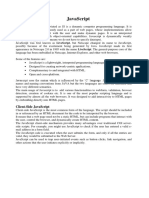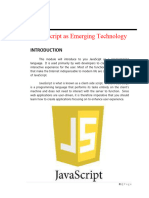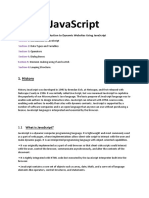0 ratings0% found this document useful (0 votes)
15 viewsJava Vs Java Script
Notes regarding subject matter
Uploaded by
pataponwarrior231Copyright
© © All Rights Reserved
We take content rights seriously. If you suspect this is your content, claim it here.
Available Formats
Download as PDF, TXT or read online on Scribd
0 ratings0% found this document useful (0 votes)
15 viewsJava Vs Java Script
Notes regarding subject matter
Uploaded by
pataponwarrior231Copyright
© © All Rights Reserved
We take content rights seriously. If you suspect this is your content, claim it here.
Available Formats
Download as PDF, TXT or read online on Scribd
You are on page 1/ 2
Definition of JavaScript and Its Differences to Java
Introduction
• Importance of JavaScript in modern web development
• Brief overview of Java as a programming language
JavaScript Definition
• Definition of JavaScript (JS) as a scripting language
• Purpose and common applications of JavaScript
Key Characteristics of JavaScript
• Dynamically typed language
• Interpreted vs. compiled nature
• Prototypal inheritance model
Differences Between JavaScript and Java
1. Language Type and Purpose:
o Java: A statically typed, class-based object-oriented programming language
designed for general-purpose applications.
o JavaScript: A dynamically typed, prototype-based scripting language
primarily used for client-side web development.
2. Execution Environment:
o Java: Compiled into bytecode and executed on the Java Virtual Machine
(JVM).
o JavaScript: Interpreted directly by web browsers or runtime environments
(Node.js for server-side JavaScript).
3. Syntax and Structure:
o Java: C-like syntax with explicit class and method declarations, strong type
checking, and mandatory semicolons.
o JavaScript: C-like syntax with dynamic typing, functions as first-class
citizens, and optional semicolons.
4. Typing and Type System:
o Java: Statically typed with explicit type declarations and strict type checking
at compile-time.
o JavaScript: Dynamically typed with implicit type conversions and type
checking at runtime.
5. Concurrency and Threading:
o Java: Supports multithreading and concurrency through language features
and libraries.
o JavaScript: Primarily single-threaded with asynchronous programming
patterns using callbacks, promises, and async/await.
6. Usage in Web Development:
o Java: Used in backend server-side applications (Java EE, Spring Framework)
and Android app development.
o JavaScript: Used extensively for front-end web development (DOM
manipulation, event handling) and increasingly in backend (Node.js) and
mobile app development (React Native).
Conclusion
• Recap of JavaScript as a dynamic scripting language contrasted with Java's static,
compiled nature
• Importance of understanding the differences for effective use in respective domains
References
• Sources and further reading on JavaScript and Java
You might also like
- What Is The Difference Between Java and JavaScript Software GuildNo ratings yetWhat Is The Difference Between Java and JavaScript Software Guild1 page
- What Is The Difference Between Java and Javascript?No ratings yetWhat Is The Difference Between Java and Javascript?2 pages
- UNIT-3 Javascript: Introduction Java ScriptNo ratings yetUNIT-3 Javascript: Introduction Java Script45 pages
- 1 - Overview of JavaScript, Advantages of JS, Difference Between Java and JSNo ratings yet1 - Overview of JavaScript, Advantages of JS, Difference Between Java and JS52 pages
- Module 1 Lesson 4 JavaScipt Introduction VariablesNo ratings yetModule 1 Lesson 4 JavaScipt Introduction Variables45 pages
- comprehensive introduction to JavaScript bys notesNo ratings yetcomprehensive introduction to JavaScript bys notes2 pages
- UNIT-I Basics of JavaScript ProgrammingNo ratings yetUNIT-I Basics of JavaScript Programming43 pages
- 05-Event-Driven Programming Class notes Final SemesterNo ratings yet05-Event-Driven Programming Class notes Final Semester6 pages
- Assignment List For Bca-3 SEMESTER, 2017 Subject: Object Oriented Programming Using C++ Assigned By: Dr. Samarjit DasNo ratings yetAssignment List For Bca-3 SEMESTER, 2017 Subject: Object Oriented Programming Using C++ Assigned By: Dr. Samarjit Das3 pages
- Principles of Programming Language: BITS PilaniNo ratings yetPrinciples of Programming Language: BITS Pilani42 pages
- Object Oriented Programming: Lecture 8: Operator OverloadingNo ratings yetObject Oriented Programming: Lecture 8: Operator Overloading23 pages
- HSYD201 1 Jul Dec2024 FA1 OD V3 12072024No ratings yetHSYD201 1 Jul Dec2024 FA1 OD V3 120720243 pages
- Object Oriented Analysis and Design - SyllabusNo ratings yetObject Oriented Analysis and Design - Syllabus1 page

























































































